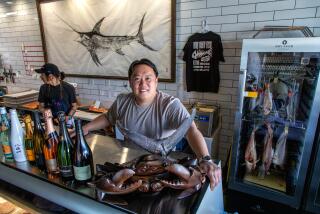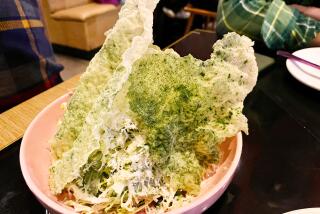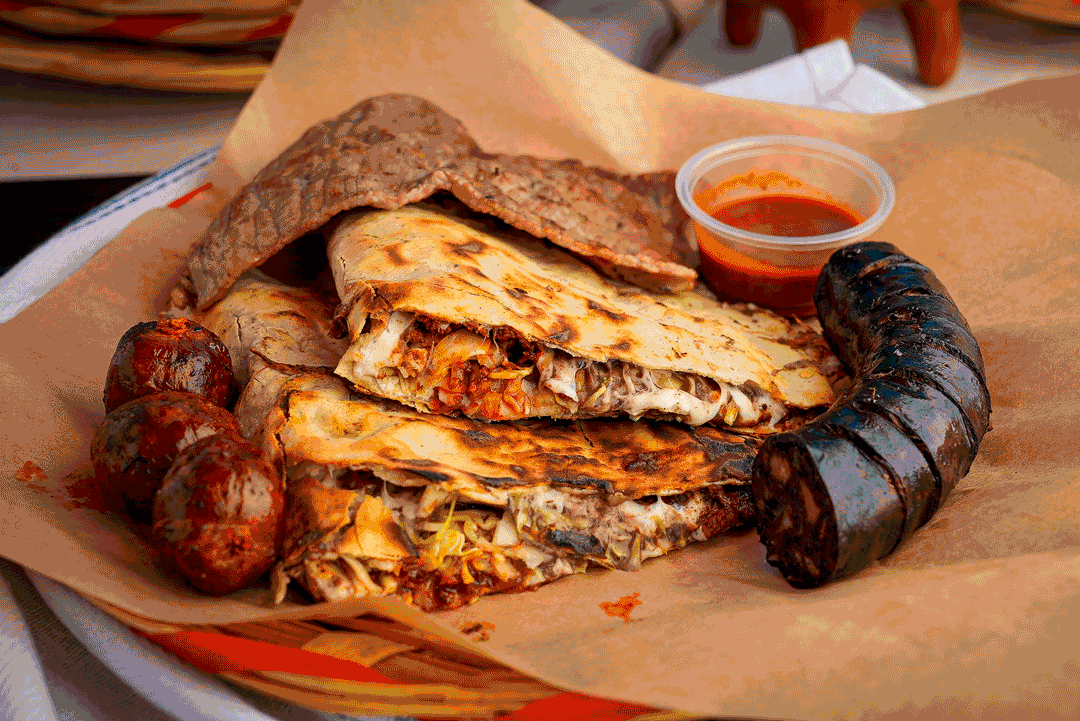Sing a Song of Salmon
- Share via
When a friend called recently to ask if I wanted to be in an opera, my first thought was: What would I cook for the opening night party?
This is not evidence of steely nerves but more likely a rather skewed sense of priorities. I envisioned a spear-carrier kind of role, notable mainly, as my daughter pointed out, for “poufy sleeves and funny pants.”
As it turned out, the role involved quite a bit more than that. And, considering the fact I’d never been on stage before, I might have done better to have concentrated on the work at hand rather than the refreshments.
I can tell you from humble experience that it is no fun to have some plummy Limey director tell you, “I’m sorry, Mr. Parsons, you are simply not musical enough to dump that wheelbarrow correctly.”
Well, I did dump the wheelbarrow correctly--after much rehearsal--and I had a lot of fun and learned a lot. One of the things I learned was how much opera and food go together.
Despite the fact that this opera (Leos Janacek’s “From the House of the Dead”) is set in a decidedly non-culinary environment--a Russian prison camp--there is a lot of food in it. In fact, the cue for my big wheelbarrow scene was when a prisoner is reminiscing about cooking for a feast. “I took the cream and whisked it; I baked the finest biscuit” . . . and I walked on. That part was easy to remember.
Later, in Act II, almost all of the action centers on a Christmas feast at which the prisoners entertain themselves with stories of how they murdered their girlfriends. It’s that kind of opera.
There were plenty of food connections offstage as well. Tenor John Duykers, a really phenomenal singer who was Mao in the premier of John Adams’ “Nixon in China” a couple of years ago, is also a garlic farmer in Northern California and is gearing up a business selling sampler packs of various varieties of garlic through the mail. The set director is the brother-in-law of one of the women who run London’s famed River Cafe.
Mostly, though, singers like to talk about eating. (Well, not just talk about it; there was more than one snide comment about this being the most unlikely looking group of Russian prisoners ever.)
Opera singers being by necessity world travelers, there was quite a lot of exchanging of notes on restaurants and dishes in various cities. Everyone seemed to have a specialty: One tenor expounded upon the various types of buns and rolls in Austria; the bass, about the intricacies of German regional sausage styles.
For the opening night party, then, it was clear there had to be a lot of food. A friend and I teamed up. She made a bunch of salads and appetizers; I brined and roasted a turkey to be carved cold.
I also planned to poach a salmon. Poached salmon is a great dish for entertaining at this time of year, because it is prepared in advance and served cold. It also lends itself to various decorations, which make a buffet, well, festive.
When I got to the market, though, it turned out the only whole salmon they had were monsters. I don’t know where these fish came from, but they looked more like sharks. A half--and the tail half at that--weighed more than 10 pounds and was about 2 feet long.
Clearly, a whole fish was going to be a problem to poach. Not only did I not have a pan big enough, I didn’t even have a stove big enough.
*
Instead, I compromised, buying the tail half, dividing it into two long fillets and poaching them (never buy the head half; about 40% of the weight is inedible). After they had chilled overnight in the refrigerator, I carefully peeled away the skin (you don’t want to remove it before poaching or you’ll lose the layer of flavorful fat).
Then I began the decorating part. I rarely go in for this kind of thing; to me, the best-looking food is the most natural-looking. But I’ll make an exception for poached salmon, which in its natural state is a fairly pallid pink.
The classical way to decorate a poached salmon is with various vegetables cut in shapes and a reduced fish stock slightly thickened with gelatin. You place a vegetable shape on the salmon and paint it with the thickened stock. Then you chill it and everything, you hope, stays in place.
I haven’t done anything like this in years. It’s too much work and too pointless for something that adds nothing to the flavor. (I don’t want to hear about “eating with your eyes”; you taste with your mouth.)
Instead, I decorated this salmon with complementary edible garnishes. First, I used my little Japanese slicer gadget to slice a cucumber very thinly. Don’t try to do this by hand unless you want to go cross-eyed; the slices should be almost transparent. I seasoned the slices with a little bit of salt, then marinated them briefly in rice vinegar (I like the faintly sweet pickled cucumbers prepared that way in Japanese restaurants).
I painted the salmon with a tarragon mayonnaise (you can make your own mayo if you prefer, but I find the Best Foods brand to be as good as anything I can do on my own), then began layering the cucumber slices over the top.
The trick here is to make sure the slices are close enough together. One row should overlap the previous one by at least three-quarters and preferably seven-eighths of the slice. The idea is to mimic the appearance of a fish’s scales. If the cucumber slices are spaced too far apart, they look like, well, misplaced cucumber slices. It sounds laborious, but each fillet took no more than 10 minutes to decorate.
The flavors work together very well: the tarragon complements the salmon and the pickled cucumbers cut through what otherwise would be an overly rich salmon-and-mayonnaise combination.
I will probably never be in another opera, but I will definitely make this salmon again and again.
OPERA SALMON
1 (3-pound) salmon fillet, in 1 piece
1 leek, white part only, chopped
2 shallots, minced
2 cups dry white wine
4 cups water
6 black peppercorns
Salt
1 large cucumber
1/4 cup rice vinegar
1/2 cup mayonnaise
2 tablespoons minced tarragon
Carefully go over flesh side of salmon with your fingertips, removing any small pin bones you feel with tweezers or needle-nose pliers.
Combine leek, shallots, wine, water, peppercorns and 1 teaspoon salt in pot big enough to hold salmon fillet. Bring to simmer and cook, uncovered, 30 minutes. If salmon head and frame are available, include them in stock too.
When stock is cooked, remove bones if used (remove meat from them and use for salad, if desired). Wrap salmon fillet in long piece of cheesecloth, leaving enough at ends to hang over sides of pot. With mixture barely simmering, place salmon fillet in pot. Cover and cook until salmon is just cooked through, about 25 minutes (fish should lighten in color but not become flaky).
Remove fish from pot and refrigerate, still wrapped in cheesecloth, tightly wrapped in aluminum foil. When chilled through, preferably overnight but at least 4 hours, remove from refrigerator and unwrap from aluminum foil and cheesecloth. Gently wipe away any flecks of leek still sticking to salmon. Carefully turn over and very gently remove thick piece of salmon skin without breaking fillet. Place fillet on smooth sheet of plastic wrap.
Mix together mayonnaise and tarragon. Set aside for 30 minutes to macerate.
Scrub cucumber to remove wax but leave unpeeled. Slice as thinly as possible, almost translucent. Mix cucumber slices, rice vinegar and 1 teaspoon salt in large bowl and toss well.
Evenly and thinly spread mayonnaise mixture over fillet. Starting at tail end of fillet, place 1 row of overlapping cucumber slices, completely covering from side to side and to edge. Repeat, working way up salmon and overlapping 3/4 of previous row, until salmon is entirely covered. Leftover cucumbers can be refrigerated and served alongside.
Wrap salmon tightly in plastic wrap and refrigerated until firm, about 1 hour. Serve cold.
8 to 10 appetizer servings. Each of 10 servings:
251 calories; 200 mg sodium; 46 mg cholesterol; 11 grams fat; 7 grams carbohydrates; 24 grams protein; 0.40 gram fiber.
* Platter from Room With a View, Snata Monica
More to Read
The biggest entertainment stories
Get our big stories about Hollywood, film, television, music, arts, culture and more right in your inbox as soon as they publish.
You may occasionally receive promotional content from the Los Angeles Times.











